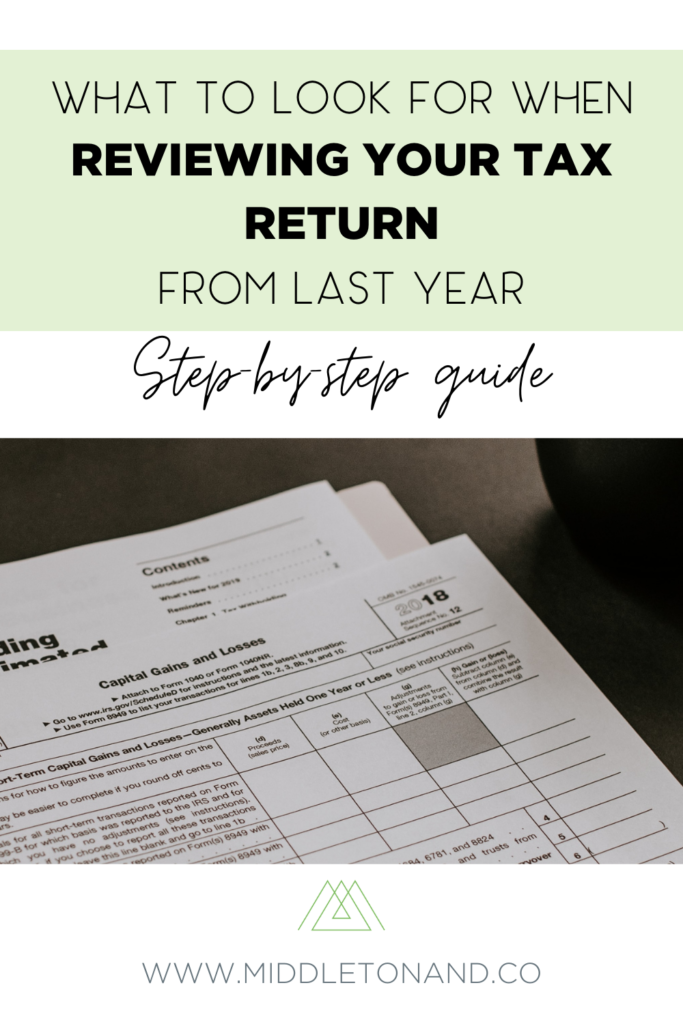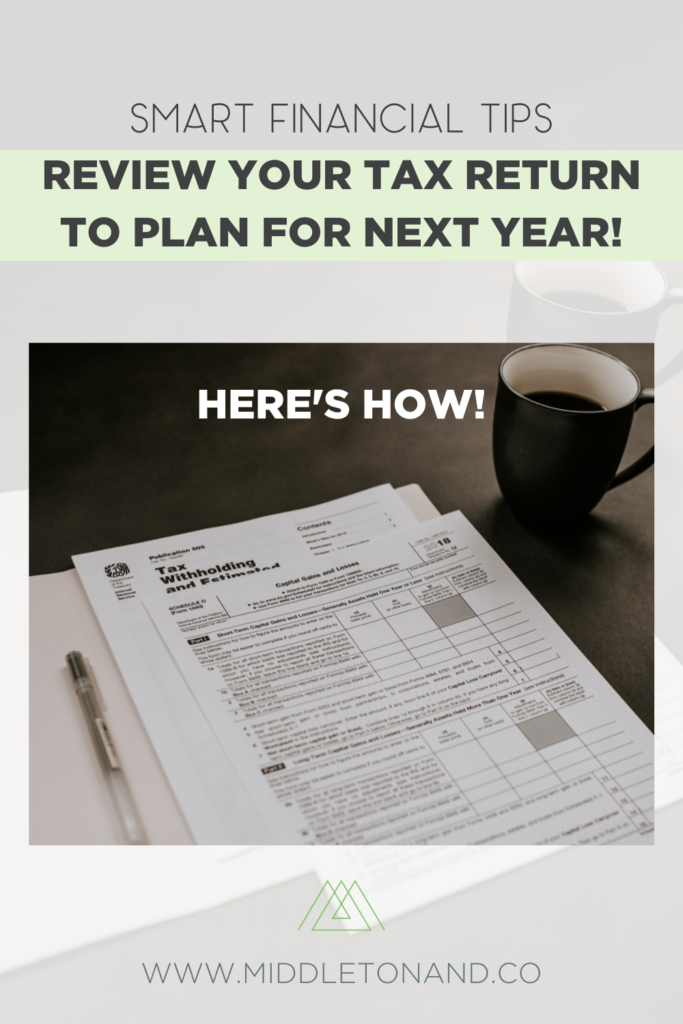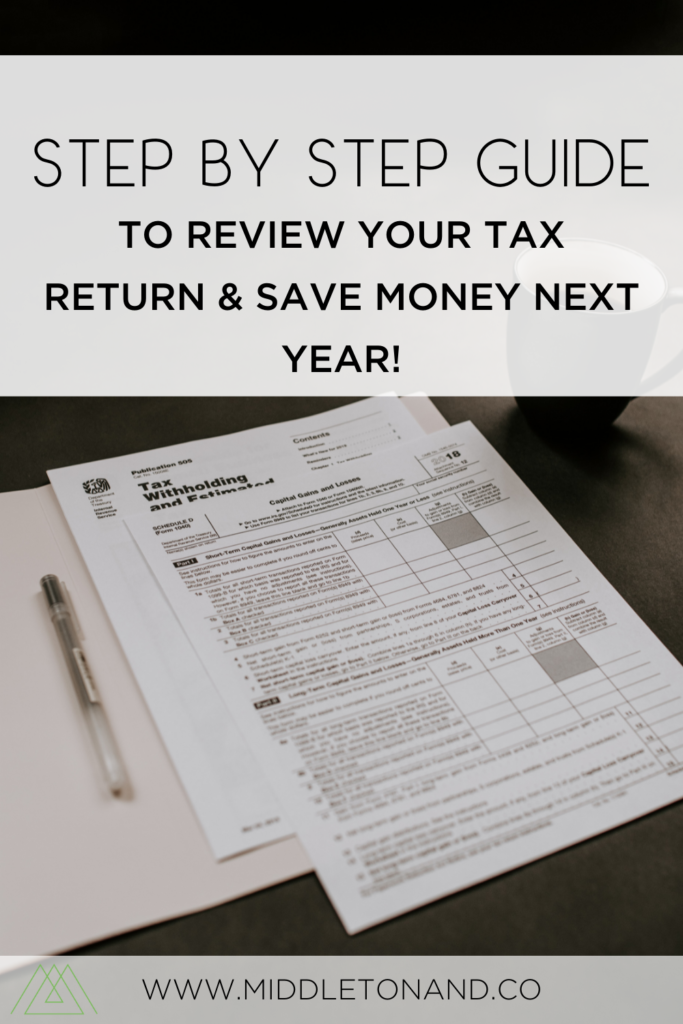Whew! You’ve made it through gathering all your tax documents for last year, you’ve either entered them into a tax preparation software or organized them for your tax preparer, and you’ve filed your return. Finally done! Let’s get on with this year, shall we?
Not so fast. Before you move on, there are benefits to looking back at your prior year’s tax information as a way to help you plan for the year(s) ahead.
Read on for details!

Why do you need to look at your previous tax return?
Here are some reasons to review last year’s tax return:
- Understanding your current tax bracket, and whether there are options for managing your taxable income going forward (this will be done through understanding your AGI and MAGI which we’ll explain more below)
- Confirming that everything was entered correctly can either show that filing an amended return may save you money, or may clarify how information should be entered in future years
How to review your tax return?
Tax forms can be daunting, so we’ve broken down some of the more important line items to understand and review as part of your analysis.
First, we’re sharing an explanation of some numbers you may see summarized on the front page of your tax return:
AGI: Adjusted Gross Income is the starting place for many phaseouts or additional taxes. This is on Line 11 on your 1040 tax form.
MAGI: This is your AGI with certain deductions added back to determine your eligibility for other deductions, taxes, or credits. There are multiple calculations for MAGI, each for a different deduction or credit. If you see any of the following on your tax return (or expected to and you don’t), it may be interesting to understand how your MAGI affected your eligibility: Lifetime Learning Credit, American Opportunity Credit, Child Tax Credit, deductible Traditional IRA contributions, Roth IRA contributions, deductible student loan interest, Affordable Care Act Premium credit, or Net Investment Income Tax
Marginal Rate: This is the rate that your last dollar earned was taxed at. The US tax system is graduated, so not all of your income was taxed at this rate. This rate can be controllable in certain circumstances.
Effective Rate: Since federal tax is graduated, you owed the amount of tax applicable to each tax bracket as you move up in income. Your Effective tax rate is the total tax you owed divided by your taxable income. It will be lower than your Marginal Rate.
1040 Detailed Analysis (based on 2021 tax form)
- Line 1 Wages: This comes from your W-2 (see a list of tax documents here) and often does not match your stated salary amount. This number is net of pre-tax 401(k), 403(b) or 457 contributions, and may also have other amounts deducted for things like HSA contributions.
- Line 2 Interest: If you are in a higher marginal tax rate (22%+), is your tax-exempt interest higher than your taxable interest? If not, you may be able to adjust your portfolio to be more tax efficient.
- Line 3 Dividends: Same as above. Are your qualified dividends a large percentage of your ordinary/total dividends?
- Line 4 IRA Distributions: Are the amounts in 4a and 4b equal? There are cases where they should be different, including rollovers, backdoor Roth contributions, and Roth conversions. If you have reportable distributions for any of these reasons, double-check that the taxable distribution amount is less than the full distribution amount.
- Line 7 Capital Gain: If this number is ($3,000), there may be opportunities for carry forward losses in future years.
- Line 10 Adjustments to Income: This number includes contributions you made directly to an HSA, SEP IRA, or a Traditional IRA. It also captures deductions for self-employed health insurance expenses and student loan interest payments. How did these adjustments affect your taxable income? Did they change your marginal tax rate? These contribution and expense amounts can be within your control, and there may be an opportunity to adjust your contributions or select a different type of account, or plan to reduce your tax liability.
- Line 11 AGI: What is your AGI? Remember that this is the starting place for many phaseouts or additional taxes.
- Line 12 Itemized or Standard Deduction: Did you take the Itemized or Standard Deduction for this tax year? Were your eligible itemized deductions close to the Standard Deduction? If so, there may be strategies to increase your itemized deductions in certain years to reduce your tax liability. For example, bunching charitable contributions every other year can improve the tax benefit you receive for your charitable giving.
- Line 12b Charitable Contributions (ending in 2021): If you took the Standard Deduction, there may be a number on this line if you also did some charitable giving. If there is, be sure to keep receipts from the charitable organizations to document your contributions. If this is blank, but you did make cash contributions to a charitable organization, you may have missed a deduction you were eligible for.
- Line 13 QBI Deduction: If you own a business, is there an amount on this line? Is it time to consider more detailed business planning? If there is a small amount on this line, it may mean you have money invested in a Real Estate Investment Trust (REIT). REIT dividends are not considered qualified dividends, so if you own a REIT in a taxable account, it’s good to understand the impact the dividends have on your overall tax liability.
- Line 15 Taxable Income: This is the amount that determines your actual tax amount. It may also indicate that you qualify for a lower (or higher) capital gain tax rate – 0% (or 20%).
- Line 16 Tax: This is the actual amount of tax you owe. It can include tax calculated on other tax forms, so review all schedules and forms to understand how this number is derived.
- Line 17 Other Taxes: See any information entered on Schedule 2, lines 1-3 to understand where this number comes from. Alternative Minimum Tax (AMT) can be triggered by a number of specific events. If you have questions about this affecting you, it may be time to consult with a CPA. If you received advance premium tax credit payments that ended up being more than you qualify for now that your tax return is complete, credit repayment is added to the tax in the previous line.
- Line 19 Nonrefundable Child Tax Credit/Credit for Other Dependents: This number comes from Form 8812 if you have children or other dependents. Form 8812 changed significantly in 2021, so it may be worth reviewing the updates and how they apply to your situation.
- Line 20 Other Nonrefundable Credits: This number comes from Schedule 3, which includes a number of other tax credits, including the foreign tax credit, credit for child or dependent care expenses, and residential energy credits.
- Line 23 Other Taxes: This line includes Self-Employment tax. If you are a business owner, this is another area where business planning and strategy may have an impact on your tax liability. Additionally, this line includes the Net Investment Income Tax (NIIT), which is a 3.8% additional tax paid on the lesser of net investment income or MAGI over a certain threshold. Are you subject to NIIT?
- Line 24 Total Tax: This is how much you owe in tax. It doesn’t include any amount you’ve already paid or have qualified for in credits (see below). The amount you owe is calculated based on your filing status and a series of graduated tax brackets. Check out this article for more information, and see the definitions for both marginal and effective tax rates above.
- Line 27 Earned Income Credit: This credit applies to households with low to moderate-income. Review qualifications on the IRS website. This is a refundable credit (see below).
- Line 28 Refundable Child Tax Credit/Additional Child Tax Credit: This is a refundable credit, meaning that the refund can be larger than the tax you owed, in 2021. It is scheduled to revert to a nonrefundable credit and will be at a lower amount in 2022.
- Line 29 American Opportunity Credit: Did you have educational expenses? Double-check whether you were able to maximize your credit by reviewing this information.
- Line 30 Recovery Rebate Credit: This credit is applicable for 2021 only; it is not planned to continue for 2022.
- Line 34 Refund: If your refundable credits and the tax payments you made throughout the year through tax withholding or estimated payments were higher than your Total Tax, this is your refund amount. If this is a relatively large amount, like $1,000 or more, consider that this is essentially an interest-free loan to the government. If the amount is a very large number, it may take longer to receive the refund. You may consider adjusting withholding to make your tax paid throughout the year more closely match your Total Tax. You can also have the refund amount applied to estimated taxes for next year.
- Line 37 Amount You Owe: If your Total Tax was higher than your refundable credits and the tax payments you made throughout the year through tax withholding or estimated payments, this is the amount you owed. Was this a large number? Was it a surprise? Was there a one-time event that caused additional tax to be owed last year? What might you expect for this year?
- Line 38 Penalty: We often think of federal taxes as an annual process, but it’s actually a pay-as-you-go system. Did you owe any penalty last year? If so, you may consider increasing withholding and/or estimated tax payments.
- Paid Preparer Section: Did you self-prepare your taxes or have a tax preparer or CPA help you? If you identified areas above where you have questions, are unsure of your calculations, or if you have more complicated tax situations with business, partnership, or trust incomes, it might be worth considering professional tax preparation as your taxes become more complicated.
As you see, a lot of information is on your tax return document! And not just information about the past, but helpful data for this year and the upcoming years.
Notice that some areas and line items are controllable. Others are available for specific time periods/tax years and then change. It can be helpful to either stay on top of annual tax code updates yourself or work with a professional(s) to help highlight how those updates impact you.
That’s why it can be worth reviewing past tax returns. They not only help you understand what happened in the last year, but they can also help you make adjustments in the current and coming years.
Do you have additional schedules and tax forms? Have questions about your detailed tax situation and how it may affect your sabbatical plans? Click here to schedule with us and learn more about how managing your taxes can be a strategy to consider.
Like this article? Make sure to Pin It so you can go back to it later!



